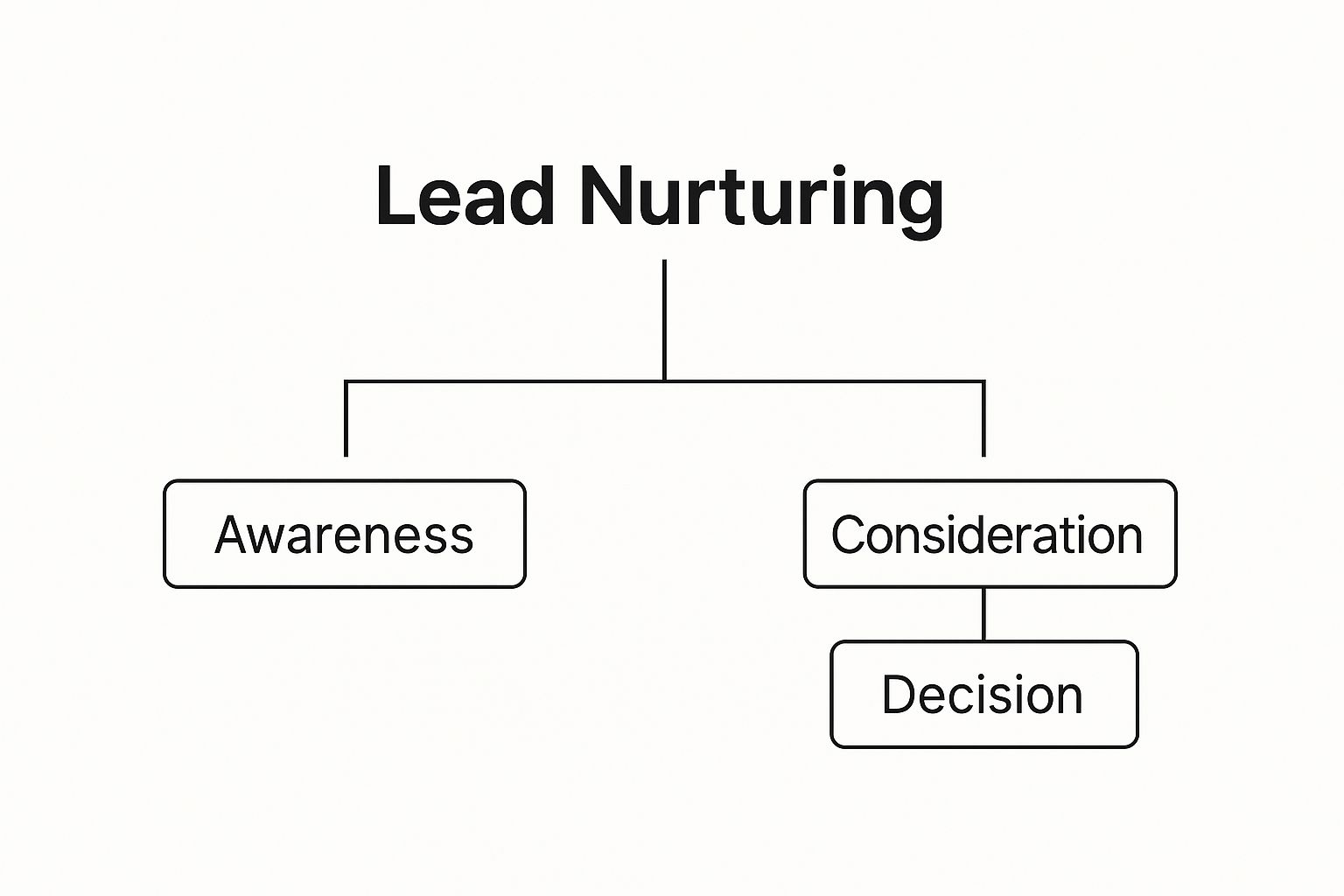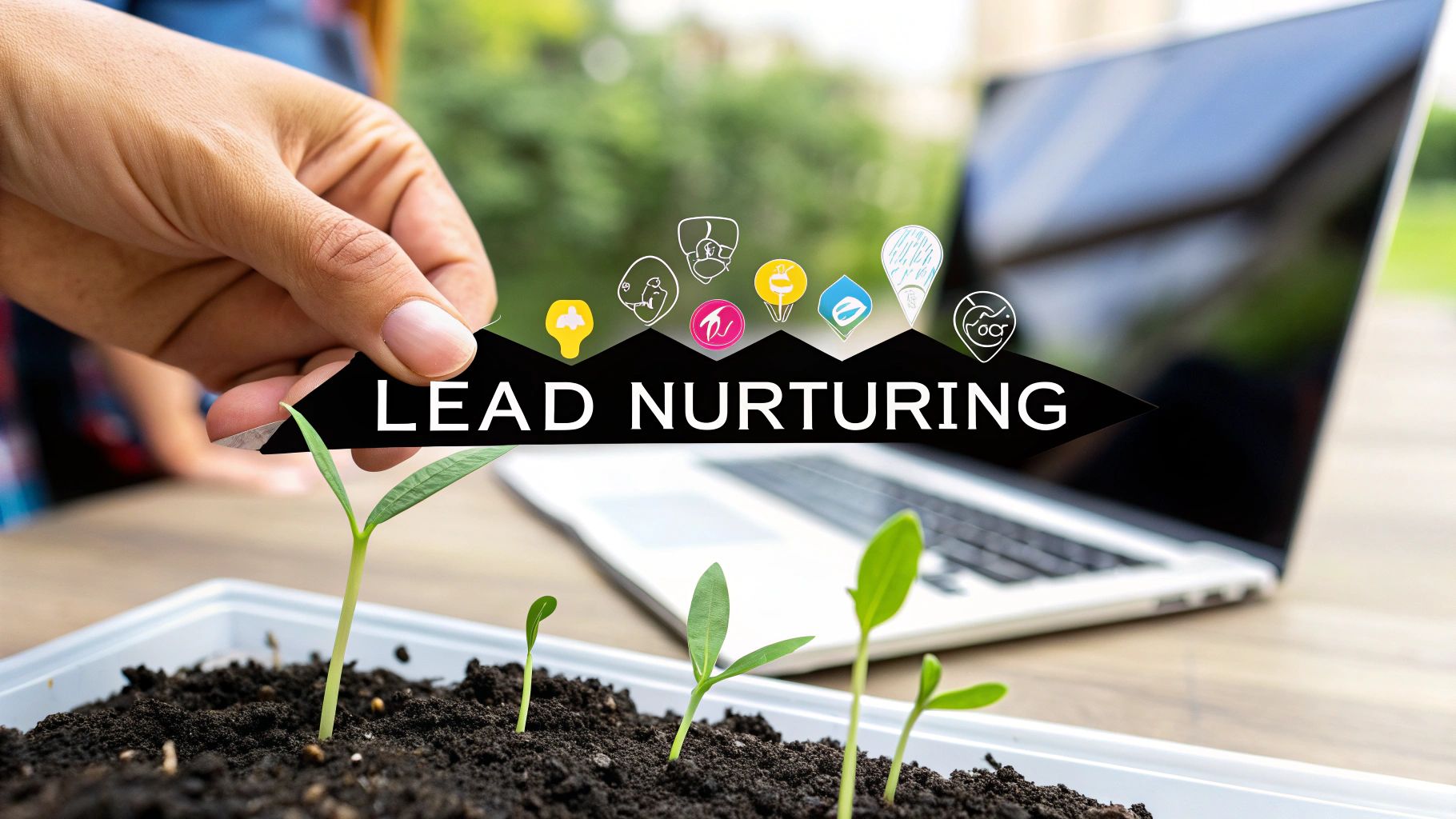What Is Lead Nurturing and How Does It Work?
So, what exactly is lead nurturing? Think of it as the art of building a relationship with potential customers before they're even thinking about buying. It’s not about a hard sell. Instead, it’s about consistently providing genuinely useful information that helps them solve their problems and positions your brand as the go-to expert they can trust.
Turning Mild Interest Into a Real Opportunity

I like to compare lead nurturing to tending a garden. You can't just throw a seed in the ground and expect a healthy plant the next day. It needs consistent care—water, sunlight, and the right soil—to grow strong. In the same way, you cultivate relationships with prospects who've shown a flicker of interest but aren't ready to pull out their wallets just yet.
This whole process is a carefully planned series of touchpoints. We're talking about things like targeted emails, helpful content, and even social media interactions, all designed to gently guide people through your sales funnel. The goal is to educate and inform, not just to pitch your product. By offering valuable resources—think insightful blog posts, detailed case studies, or practical webinars— you build serious credibility and make sure your brand is the first one they think of when they are ready to buy.
From Unsure Prospect to Confident Customer
The difference between a lead you've nurtured and one you haven't is night and day. One person feels heard, understood, and supported on their journey. The other is basically left to fend for themselves. This thoughtful approach has a massive impact on the bottom line.
In fact, businesses that get lead nurturing right generate 50% more sales-ready leads and manage to do it at a 33% lower cost. That’s a huge win. If you want to dive deeper into the numbers, this overview on lead nurturing statistics from Salesgenie is a great resource.
Ultimately, lead nurturing is the essential bridge that connects someone's initial curiosity with their final decision to choose you.
Nurtured Lead vs Non-Nurtured Lead at a Glance
The table below really drives home just how different the outcomes can be when you invest in building relationships versus when you don't.
| Characteristic | Nurtured Lead | Non-Nurtured Lead |
|---|---|---|
| Engagement Level | High; interacts with multiple pieces of content over time. | Low; often a single interaction with no follow-up. |
| Trust in Brand | Strong; sees the company as a credible expert. | Weak or non-existent; views the company as just another vendor. |
| Sales Readiness | High; well-informed and prepared for a sales conversation. | Low; unqualified and often surprised by a sales call. |
| Conversion Likelihood | Significantly higher due to the established relationship. | Very low; likely to drop out of the sales funnel early. |
As you can see, the contrast is stark. A nurtured lead isn't just a contact; they're a well-informed, engaged prospect who is far more likely to become a valuable, long-term customer.
Why You Can't Afford to Ignore Lead Nurturing

Let’s get one thing straight: generating a lead is just the starting line, not the finish. The real magic—and the real money—is in what happens next. This is where lead nurturing comes in, and it’s non-negotiable for a simple reason: most people who show interest in your business aren’t ready to buy right away.
Think of it less like a transaction and more like building a relationship. You're not just sending follow-up emails; you're strategically building trust and proving you're the expert.
By consistently offering helpful content that actually solves their problems, you become their go-to resource. When the time comes for them to finally pull out their wallet, you’re the first one they’ll think of. This kind of thoughtful engagement also has a great side effect—it seriously shortens the sales cycle. An informed prospect is an easy prospect, letting your sales team focus on what they do best: closing.
The Direct Path to Business Growth
When you get lead nurturing right, the results aren't just fuzzy feelings; they show up on your bottom line. Building a genuine connection shifts the dynamic. You stop being just another vendor and become a trusted advisor.
That trust is everything. When you guide a lead through their decision-making process, you're not just selling—you're creating a better experience. This naturally turns into more valuable, long-term business.
It also translates to bigger deals. Nurtured leads feel more confident in what you're offering, which is why they tend to spend more. How much more? Research shows that nurtured leads make purchases that are 47% larger than non-nurtured ones. You can dig into the data yourself in this research from Zendesk.
Ultimately, a solid nurturing process creates a sales pipeline you can actually count on. Instead of letting good leads go cold, you build a system that gets the most out of every single one. It’s a core part of figuring out how to improve customer experience from start to finish.
The Three Pillars of an Effective Nurturing System
A solid lead nurturing program isn't just a collection of random emails and follow-ups. It's a carefully constructed system, built on three core pillars that work in harmony to guide a potential customer from a flicker of interest to a confident purchase.
Getting these components right is what separates a haphazard approach from a well-oiled machine that delivers real, predictable results. Let's break down what they are.
1. Strategic Lead Scoring
The first pillar is lead scoring. Think of it as a built-in priority system for your sales team. You assign points to leads based on specific actions they take—visiting your pricing page, downloading a case study, or signing up for a webinar.
This simple but powerful method allows you to instantly see who's just browsing versus who is genuinely engaged and ready for a conversation. It directs your sales team’s valuable time and energy to the leads most likely to close, making their efforts far more effective.
2. Powerful Marketing Automation
Next up is marketing automation, which is essentially the engine that drives the entire process. This technology is what makes nurturing at scale even possible. It handles the repetitive, time-consuming tasks like sending personalized follow-up emails, segmenting your audience based on their interests, and triggering campaigns based on a lead's behavior.
Without automation, you'd be stuck in a never-ending cycle of manual tasks. With it, you can deliver a seamless, timely, and relevant experience for every single prospect without burning out your team.
3. Relevant and Targeted Content
Finally, the fuel for your nurturing engine is targeted content. This is the substance of your communication—the actual value you deliver to your leads. The key here is relevance. The content you send must match where that person is in their buying journey.
Someone just discovering they have a problem needs different information than someone actively comparing solutions. This diagram perfectly illustrates how content should evolve as a lead moves from awareness to consideration and, finally, to a decision.

As you can see, a one-size-fits-all content strategy just won't cut it. Your approach has to be flexible and adapt to your customer's changing needs and mindset.
How to Build Your First Nurturing Campaign

Alright, let's move from theory to action. This is where lead nurturing gets really interesting. Building your first campaign doesn't have to be some monumental task; it just needs a clear, logical plan. Think of it less like building a rocket ship and more like creating a personalized roadmap for your prospect—one that guides them from that first "hello" all the way to a meaningful sales conversation.
The whole thing starts with one simple question: What's the goal? Are you trying to warm up a list of cold leads? Onboard new blog subscribers? Or maybe you want to nudge prospects who downloaded your latest guide toward booking a demo. Your objective is your north star; it shapes every single decision you make from here on out.
Start With Your Audience and Their Journey
Once your goal is set, you need to know exactly who you're talking to. This is where audience segmentation comes in. It’s simply the process of grouping leads based on things they have in common, like their industry, job title, or the specific piece of content that caught their eye. This step is what separates a message that feels genuinely helpful from one that feels like generic spam.
With your segments defined, it's time to map out their journey. What are the logical steps a lead needs to take to feel confident in your solution? Your campaign should act as a guide along that path, delivering the right information at the perfect moment. For example, your first email might offer a helpful blog post, while a later one could introduce a detailed case study that speaks directly to their biggest challenges.
This is where you can see the magic of a structured approach. It's a key part of a larger system, and you can learn more about how it fits together in our guide on how to automate lead generation.
Build Out Your Workflow and Measure What Matters
With the customer journey mapped out, you can start building the actual automated workflow. This is just a sequence of touchpoints—usually emails—that are triggered by a specific action, like a form submission. While you can nurture leads on other channels, email is still the undisputed king. In fact, a whopping 69% of marketers rely on email for their nurturing efforts.
To bring this to life, here’s what a simple 5-touch email sequence might look like for a new lead who just downloaded an e-book.
Sample 5-Touch Email Nurture Sequence for a New Lead
| Day | Email Content Focus | Goal |
|---|---|---|
| 0 | Instant delivery of the requested guide. | Fulfill the promise and build immediate trust. |
| 2 | Follow-up with a related blog post or short video. | Provide additional value and reinforce your expertise. |
| 5 | Share a customer success story or case study. | Build social proof and show real-world results. |
| 8 | Address a common pain point with a practical tip. | Demonstrate empathy and problem-solving ability. |
| 12 | Soft call-to-action for a demo or consultation. | Gently transition from education to a sales conversation. |
This is just one example, of course. The key is to create a logical flow that builds trust step-by-step.
Finally, you need to know if it's actually working. Define your success metrics from the start. Key indicators to track include:
- Click-Through Rates (CTR): Are people actually engaging with your content?
- Conversion Rates: How many leads are taking the desired action (like signing up for a trial)?
- Sales-Ready Leads: The ultimate goal—how many leads are raising their hands for a sales call?
A great nurturing campaign is a living system. Continuously monitor your metrics and refine your approach based on what the data tells you. This feedback loop is the key to long-term success.
Common Nurturing Mistakes and How to Avoid Them
Even the most thoughtfully designed nurturing strategies can fall flat if you stumble into a few common traps. Sometimes, knowing what not to do is just as critical as having a solid plan.
One of the biggest blunders? Coming on too strong, too fast.
Hitting a new lead with a hard sales pitch or a demo request in the very first email is the marketing equivalent of proposing on a first date. It’s a huge turn-off. The real goal here is to build trust and a relationship by offering genuine value, not to corner them into a sale right out of the gate.
Another classic mistake is the "set it and forget it" approach. Your nurturing campaign isn't a slow cooker; you can't just throw everything in and walk away. It’s a living, breathing part of your marketing that needs constant attention. You have to be in there, checking the data, tweaking your messaging, and adapting to what's actually working.
Dodging Impersonal and Irrelevant Messages
Sending generic, one-size-fits-all emails is the fastest way to get ignored, deleted, or marked as spam. Real personalization is so much more than just plugging in a {first_name} field. It’s about sending content that actually resonates with your lead's specific industry, their unique challenges, and where they are in their buying process.
This is where smart segmentation comes in. Someone who just downloaded their first ebook needs foundational, educational content. On the other hand, a lead who just spent five minutes on your pricing page? They're probably ready for a compelling case study or a product comparison guide.
The best nurturing programs don't feel like marketing at all. They feel like a genuinely helpful conversation, anticipating the next question and providing the answer before it's even asked.
Finally, a huge missed opportunity is ignoring lead scoring. If you don't score your leads, you're essentially flying blind, treating a hot, ready-to-buy prospect the same as someone who's just casually browsing. A good scoring system shows you exactly who is engaged and sales-ready versus who needs a bit more time and information.
To get this right, you'll want to dive into these lead scoring best practices to help you focus your team's energy where it counts. By sidestepping these common pitfalls, you can create a nurturing system that actually builds strong relationships instead of pushing people away.
Got Questions About Lead Nurturing? We've Got Answers.
Putting a lead nurturing plan into action always brings up a few practical questions. Let's tackle some of the most common ones that pop up when you're getting started.
How Long Should a Nurturing Sequence Actually Be?
Honestly, there’s no magic number. The right length really hinges on your product's complexity and your typical sales cycle.
For a complex B2B software sale, you might be looking at a journey with 7-12 touches spread out over a few months. But for a simpler B2C product? You might only need 3-5 emails over a couple of weeks to get the job done.
The trick is to match your prospect's natural decision-making pace. Map your content to their journey and pay close attention to engagement data. That will tell you what frequency feels right, and you can adjust as you learn.
What Kind of Content Should I Send?
The best nurturing content is always helpful content. What's helpful, though, changes depending on where the lead is in their buying process.
- Just Looking (Early-Stage): Focus on pure education. Think blog posts, insightful infographics, and introductory guides that build awareness and establish you as a trusted resource.
- Getting Serious (Mid-Stage): Now it’s time to offer content that helps them evaluate their options. Webinars, detailed case studies, and comparison sheets are perfect here.
- Ready to Decide (Late-Stage): It's time to get specific. This is where you offer demos, free trials, and clear, straightforward pricing details to help them make a final choice.
Your goal isn't just to send emails; it's to consistently provide value and answer the questions they have at each step, building your credibility along the way.
Do I Need to Buy Expensive Software Right Away?
Not necessarily. While dedicated platforms like HubSpot or Pardot are incredibly powerful, you don’t need to break the bank on day one.
Many modern email marketing tools have basic automation features built right in. You can easily set up simple, trigger-based email sequences to get started. You can even begin by manually segmenting your audience and sending a pre-planned series of messages. It takes more hands-on effort, but it's a fantastic way to prove the concept before you invest in a bigger system.
Ready to stop letting valuable leads slip through the cracks? MakeAutomation specializes in building powerful, automated nurturing systems that turn interest into revenue. Discover how our tailored frameworks can accelerate your growth.







